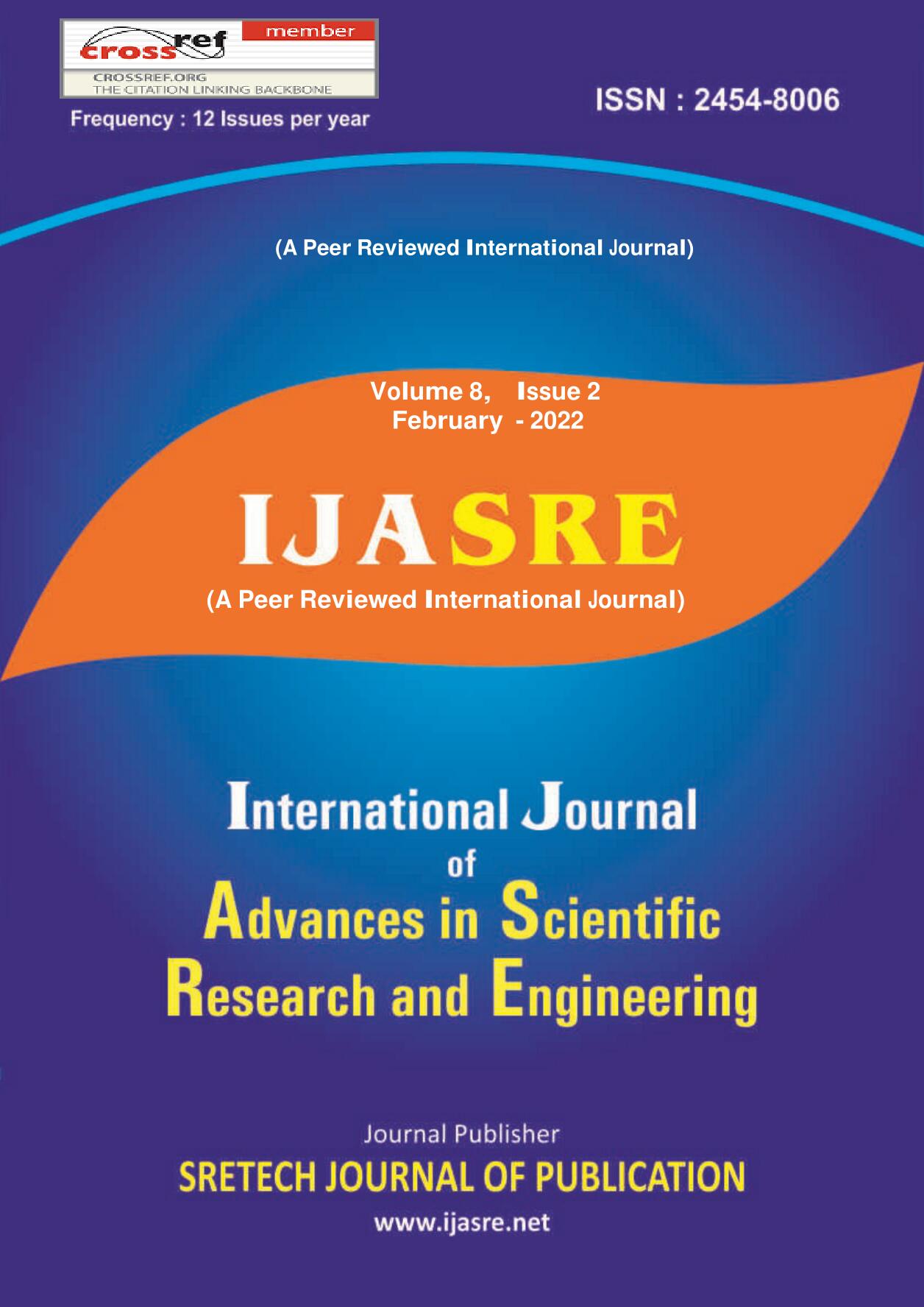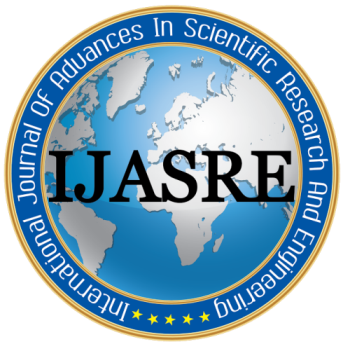Agro - Meteorological data Collection using a LoRaWAN - Based IoT Sensor Network
DOI:
https://doi.org/10.31695/IJASRE.2022.8.2.15Keywords:
Internet of Things, LoRaWAN, LPWAN, Meteorological station, Web ApplicationAbstract
Generally, the variation of meteorological conditions has a significant influence on the agriculture sector in general. In Tanzania, the study conducted in 2015 found most of the existing automatic meteorological stations are not working, and the surveyed manual meteorological stations record meteorological data in the cards daily, but cards are sent in a month to month time interval to the respective organs, this makes the concept of early warning difficulty. Therefore having near real-time meteorological data will enable the crop monitoring and forecasting systems to monitor crop development and provide early warning to the farmers and the government.
The advancement of the Internet of Things (IoT) offers possibilities for developing an integrated sensors network to collect meteorological data on a near-real-time basis. In this study, the developed integrated sensor network includes sensors, which record remote meteorological data such as rainfall, humidity and temperature, a communication network, and a web application that enhance data visualization in both graphical and tabular format. In the communication system, the LoRa technology was used, which is more preferable compared to other Low Power Wide Area Network (LPWAN) technologies such as NB-IoT and Sigfox for this application. The developed system uses the LoRa Gateway Operating system which provides capabilities to build a private network, and make it more cost-efficient by reducing the operation cost for account subscription, in online platforms such as The Things Network (TTN), ThingPark, ThingSpeak, and Loriot to avoid free accounts limitations. Moreover, the developed system can work in remote areas with limited Internet access as the meteorological stations can communicate with the gateway at a distance of up to 25 km.
References
Albert, P., & Haslhofer, F. (2017). Practical Limitations for Deployment of LoRa Gateways.
Boano, C. A., Cattani, M., & Kay, R. (2017). Impact of Temperature Variations on the Reliability of LoRa An Experimental Evaluation.
Butun, I., & Pereira, N. (2019). Security Risk Analysis of LoRaWAN and Future Directions. 1–22. https://doi.org/10.3390/fi11010003
Byanyuma, M., Kalolo, S., Mrutu, S. I., Nyakyi, C., & Sam, A. (2013). Affordable Broadband Connectivity for Rural Areas. 62–65.
Cattani, M., Boano, C. A., & Römer, K. (2017). An Experimental Evaluation of the Reliability of LoRa Long-Range Low-Power Wireless Communication. https://doi.org/10.3390/jsan6020007
Dambal, V. A., Mohadikar, S., Kumbhar, A., & Guvenc, I. (n.d.). Improving LoRa Signal Coverage in Urban and Sub-Urban Environments with UAVs. 2019 International Workshop on Antenna Technology (IWAT), 210–213.
Fehri, C. El, Kassab, M., Abdellatif, S., Berthou, P., & Belghith, A. (2018). LoRa technology MAC layer operations and Research issues. Procedia Computer Science, 130, 1096–1101. https://doi.org/10.1016/j.procs.2018.04.162
Haxhibeqiri, J. (2018). A Survey of LoRaWAN for IoT : From Technology to Application. https://doi.org/10.3390/s18113995
Home | ThingPark LoRaWAN developer Portal. (n.d.). Retrieved October 21, 2019, from https://partners.thingpark.com/en
Jovalekic, N., Pietrosemoli, E., & Zennaro, M. (2017). Smart and Very Distant Objects. https://doi.org/10.1145/3127502.3127514
Kondela, E., Nungu, A., & Pehrson, B. (2015). Status of Existing Weather Observation Station Network in Tanzania and the Possibility to Automate and Densify it.
Lavric, A. (2019). LoRa ( Long-Range ) High-Density Sensors for Internet of Things. 2019.
Li, S., Raza, U., & Khan, A. (2018). How Agile is the Adaptive Data Rate Mechanism of LoRaWAN ?
Limitations: data rate, packet size, 30 seconds uplink and 10 messages downlink per day Fair Access Policy - End Devices (Nodes) - The Things Network. (n.d.). Retrieved October 14, 2019, from https://www.thethingsnetwork.org/forum/t/limitations-data-rate-packet-size-30-seconds-uplink-and-10-messages-downlink-per-day-fair-access-policy/1300
LoRa Server - LoRa Server Server documentation. (n.d.). Retrieved October 14, 2019, from https://www.loraserver.io/loraserver/overview/
LORIOT. (n.d.). Retrieved October 14, 2019, from https://www.loriot.io/technology.html
Mekki, K., Bajic, E., Chaxel, F., & Meyer, F. (2019). A comparative study of LPWAN technologies for large-scale IoT deployment. ICT Express, 5(1), 1–7. https://doi.org/10.1016/j.icte.2017.12.005
Noreen, U., Ahcenebounceuruniv-brestfr, E., & Clavier, L. (2017). A Study of LoRa Low Power and Wide Area Network Technology.
Polonelli, T., Brunelli, D., Marzocchi, A., & Benini, L. (2019). Slotted ALOHA on LoRaWAN-design, analysis, and deployment. Sensors (Switzerland), 19(4). https://doi.org/10.3390/s19040838
Sornin, N., Cited, R., & Sornin, N. (2016). (12) United States Patent. 2(12).
Toreti, A., Maiorano, A., De Sanctis, G., Webber, H., Ruane, A. C., Fumagalli, D., Ceglar, A., Niemeyer, S., & Zampieri, M. (2019). Using reanalysis in crop monitoring and forecasting systems. Agricultural Systems, 168(September 2017), 144–153. https://doi.org/10.1016/j.agsy.2018.07.001
Torres, F., Soriano, J., & Riva, G. (2018). First Steps in the Development of a LoRaWAN Testbench. 2018 Ninth Argentine Symposium and Conference on Embedded Systems (CASE), 7–12.
Zennaro, M., Rainone, M., & Pietrosemoli, E. (n.d.). Radio Link Planning made easy with a Telegram Bot . 1–10.
Zhou, Q., Zheng, K. A. N., Member, S., Hou, L. U., Xing, J., & Xu, R. (2019). Design and Implementation of Open LoRa for IoT. IEEE Access, PP, 1. https://doi.org/10.1109/ACCESS.2019.2930243
Zinas, N., Kokkonis, G., & Valsamidis, S. (n.d.). Proposed open source architecture for Long Range monitoring . The case study of cattle tracking at Pogoniani . 1–6.
Downloads
How to Cite
Issue
Section
License
Copyright (c) 2022 Gaudence L. Mathew, Dr. Mussa Ally Dida

This work is licensed under a Creative Commons Attribution-NonCommercial 4.0 International License.








